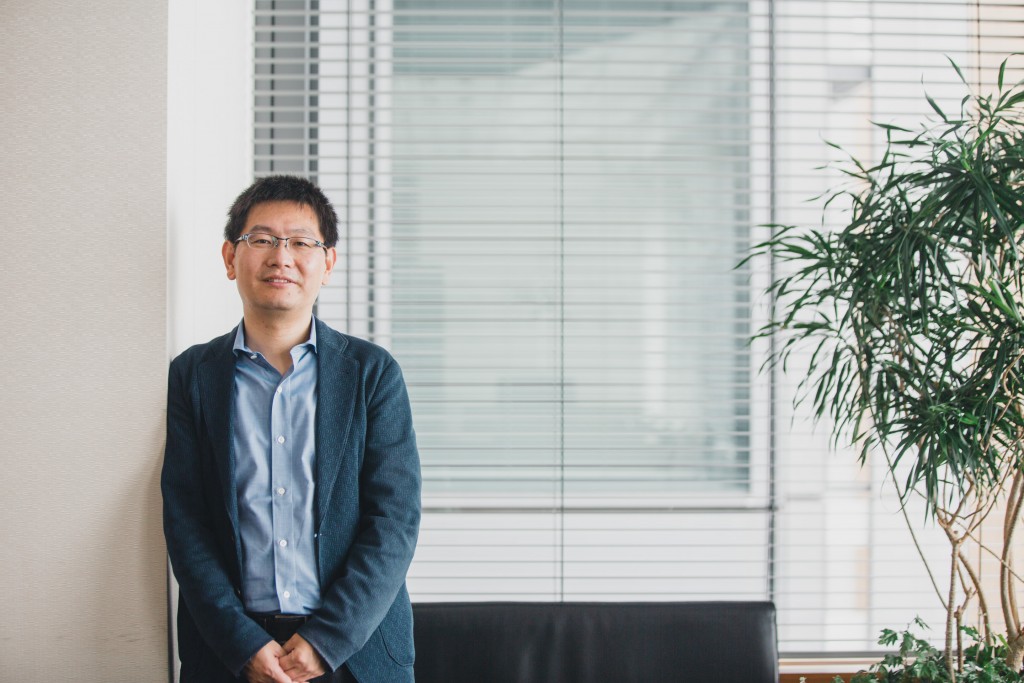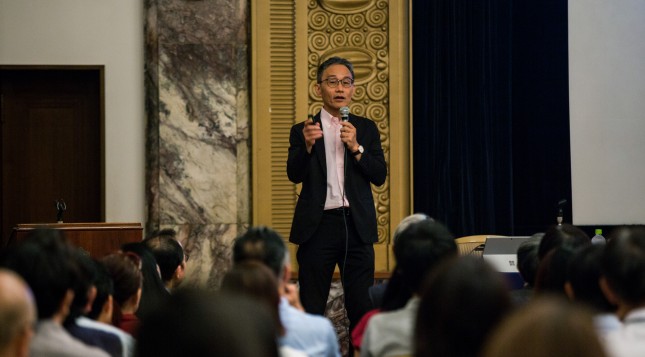Stores in China introduced virtual fitting and remote sales record average sales of ¥17 mil./month per salesperson. Utilizing automatic precision sizing and virtual fitting resolves issues in the apparel industry
The spread of COVID-19 has hurt the apparel industry severely. “However, we still have options,” said Son Hō, representative of Apatech Japan Ltd. “The Japanese market, which has a much lower rate of e-commerce adoption than other countries, is likely to find opportunities by converting to virtual business.” Virtual fitting using created reality technology (natural composite imagery) has been put into practice in China and has drastically increased the e-commerce sales rate. We asked about the concept of Apatech Japan and its technology, aimed at reforming the apparel industry by promoting this technology during the COVID era.
INDEX
・“CR technology” that achieves realistic fitting virtually
・Changing relationships between physical stores and online sales
・Key points

Son Hō
Representative Director, Apatech Japan Ltd.
Born in 1976. In 2001, graduated from Kobe University of Commerce, Hyogo. In 2002, graduated from master’s program at Napier University, Edinburgh, UK. In March 2005, completed the graduate program at the Graduate School of Economics, Kyoto University.
In 2005, joined Wanmeng Investment Management Ltd. (Beijing). After working at IBS Securities Co., Ltd. and Starts Investment Management Co., Ltd., established Apatech Japan Ltd. in October 2019.
“CR Technology” That Achieves Realistic Fitting Virtually

―― In the spring of 2020, a virtual presentation of new clothing lines using your services became a symbolic success story in the fashion industry, in spite of the COVID-19 pandemic.
Son:Yes. Stores that have introduced a virtual fitting remote sales system for U.S. and European luxury brands that utilize our fitting services have earned average sales of approximately ¥17 million per month per salesperson, even though they voluntarily closed during the COVID-19 pandemic. I think this was a ground-breaking event in the fashion industry. Of course, this happened in mainland China, with its large population, but the fact remains that the achievement was among luxury brands.
――Could you tell us more about the virtual fitting service used here?
Son:This is a virtual fitting system that utilizes created reality technology that matches vast physical data from fashion models with AI clothing data. Apatech Japan piloted it in actual stores to demonstrate the increased efficiency of store operating costs.
――When we saw the demonstration online, we were surprised by the level of reproduction. It appeared as if the model was actually wearing the clothing.
Son:It realistically and accurately reproduces details ranging from shading or transparency to wrinkling or draping. You can see how it looks in a variety of poses from 360°, not just specified angles.
――Will individual consumers be able to try on virtual clothing as well?
Son:Yes, in Japan, we have been gradually developing such online platforms since August 2020.

――Please tell us more about this virtual fitting system for consumers.
Son:The system is very simple. All that is needed is clothing data and body data. Measurements of customers’ body data are taken in a physical store fitting room with an AI-equipped fixed camera. What is important here is to standardize the imaging environment in order to obtain reliable data. This means having uniform embedded software, shooting angles and distances, lighting, and so on. Similar measurement services commonly use 3D, but our services use 2.5D technology. Therefore, you can obtain more reliable body data this way.
The clothing is photographed and converted into data in a similar manner. When measuring body data, a tailor is considered most precise, but it is expensive and we cannot rule out human error in sizing. We can create highly reliable data with only 3 to 4 seconds of photography.
Changing Relationships between Physical Stores and Online Sales

――Is this technology likely to create great benefits for apparel operators?
Son:Yes. First, it will further operational efficiency improvements by reducing photography costs. Apparel businesses can minimize product photography and sizing parts of the “sasage” (photography, sizing, and writing) operations, which are said to be powerful in e-commerce. In addition to the actual photographing, these are labor-intensive tasks that take enormous amounts of time, from scheduling camera operators, hair and makeup, models, etc. In our case, models only need to be photographed once to get their physical data. Then, once you can shoot the product, you can put the combined images online within 24-72 hours. After that, you just need to photograph the products. By utilizing this technology, businesses can immediately publish images when the product sample is complete. They can sell products in advance and sell bespoke items. They can incorporate the opinions of their customers into product development.
The second advantage is increasing e-commerce sales by using virtual fitting and lowering e-commerce return rates.
Presently, returns often occur due to differences in images between photographs and actual products. Also, there are differences in size. Virtual fitting can faithfully reproduce the fitting image. Using the actual clothing data and the physical data, users can freely try on various products. Businesses can expect lowered return rates from e-commerce.
This will also lead to reduced waste losses, which are a major issue for the apparel industry, and to less CO₂ emissions due to shipping. To summarize, apparel companies are provided with “increased sales by guiding customers to e-commerce websites” and “cost reductions and streamlining by incorporating AI in the photography operations of sasage work.” For society, it will reduce the loss from wasted clothing, which is said to amount to 1 million tons and 3.3 billion items each year. This technology contributes to preserving the global environment.
――What are the advantages for customers?
Son: The main benefit is that you can shop at any time, even if you are at home. During these times, it is difficult to go to the store. You want to avoid actually going to the shops and trying on clothes that someone else might have worn. So, if you can see a virtual image that matches your body size, you can purchase it without worrying that you don’t have the real object in hand. In the future, we will achieve a one-to-one world that combines your physical size with images of the clothes you want. You will be able to experience shopping after you try it on, like you can at a physical store. If we liken it to a physical store, e-commerce currently has only products and a cash register. Here, I believe that adding a try-on function as a substitute for a salesperson will help with shopping.
Apatech is aiming to become the leading company in the field of clothes fitting. Starting with the launch of a fitting site service in Japan, we plan to expand into Asia, the United States, and the European Union by the end of the year. Our goal is to reach 1 billion individual users and 10,000 brands.

―― What will happen to physical stores?
Son:In Japan, there has been a trend from physical stores to e-commerce for a while. Sooner or later, there will be a reverse trend from e-commerce to physical stores. I think it will probably be both, not just one or the other, because ultimately, many people want to check the color and texture with their own eyes.
――What sorts of changes do you expect from current physical stores?
Son:They may introduce unattended stores or small stores with a small number of sales representatives. Assuming omnichannel retailing, the SKUs that stores require will be only one color and one size. This will save space and minimize tenant costs. In addition, the way in which they serve customers will change (due to a change in direction towards e-commerce), so small numbers of staff can support customers with their body measurements. In this sense, I think physical stores will become places with digital entertainment elements.
――That’s new retailing, and what you call FaaS.
Son:Yes. “FaaS” is a word we coined to mean Fashion as a Service, and it means providing near-future fashion solutions that integrate the apparel industry and tech. Using what we have talked about as an example, I would like to make the fashion industry better. This will be a slow and steady activity, but we need to develop a platform by matching body data with clothing data for more customers.
――Even though it is an IT solution, it is a very slow and steady accumulation.
Son: I think that the market will come to understand someday if we continue on this gradual path for 3, 5, or 7 years. We won’t grow with just one apparel brand. I believe that a successful transformation in the current social situation will lead to opportunities, something like multi-branding in the Japanese apparel business as a whole.
Key points
・Apatech Japan offers virtual fitting using created reality technology that has been put into practical use in China and has drastically increased the e-commerce sales rate.
・In China, stores with remote sales for U.S. and European luxury brands that have introduced virtual fitting have recorded average sales of approximately ¥17 million/month per salesperson during the COVID-19 pandemic.
・It is important to obtain reliable physical data to standardize the imaging environment.
・Virtual fitting can make the product shooting and sizing operations more compact and it can reduce the return rate. It also leads to reduced waste losses and less CO₂ generated in shipping.
・It is predicted that sooner or later, a reverse trend will occur. It will represent a shift from ecommerce to physical stores; the ideal style of service will also change.




 EC
EC 






